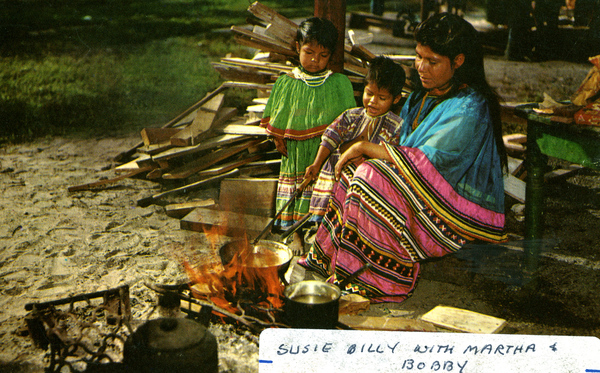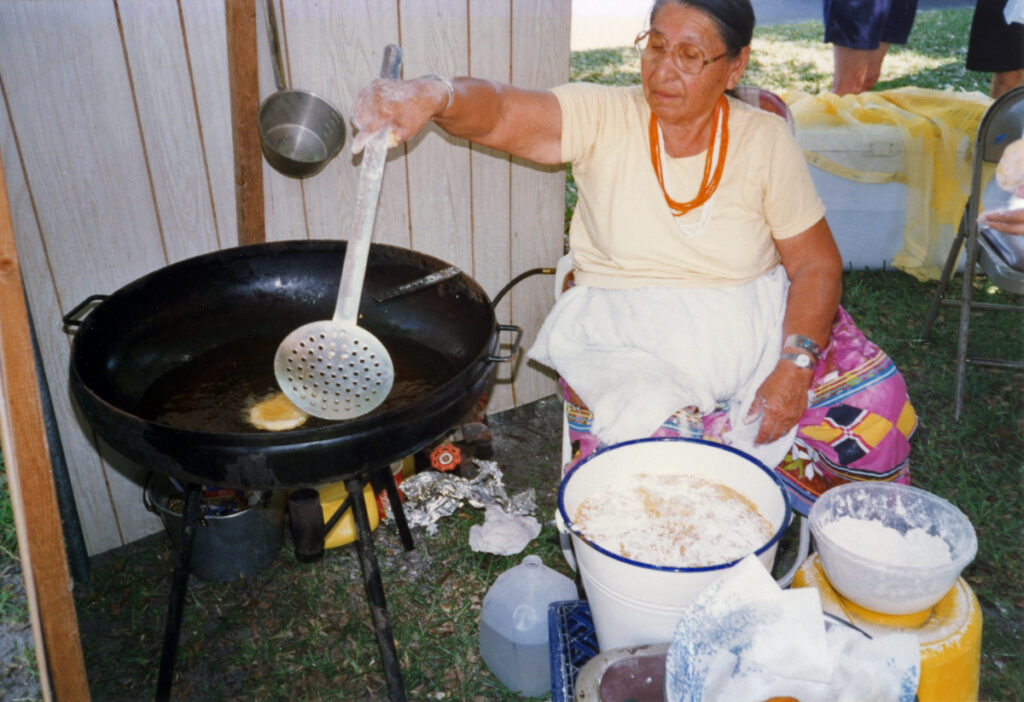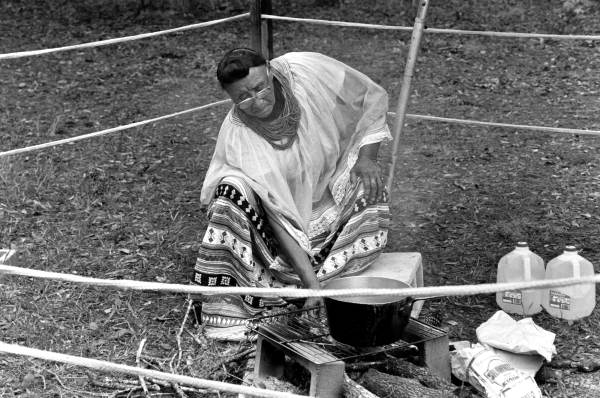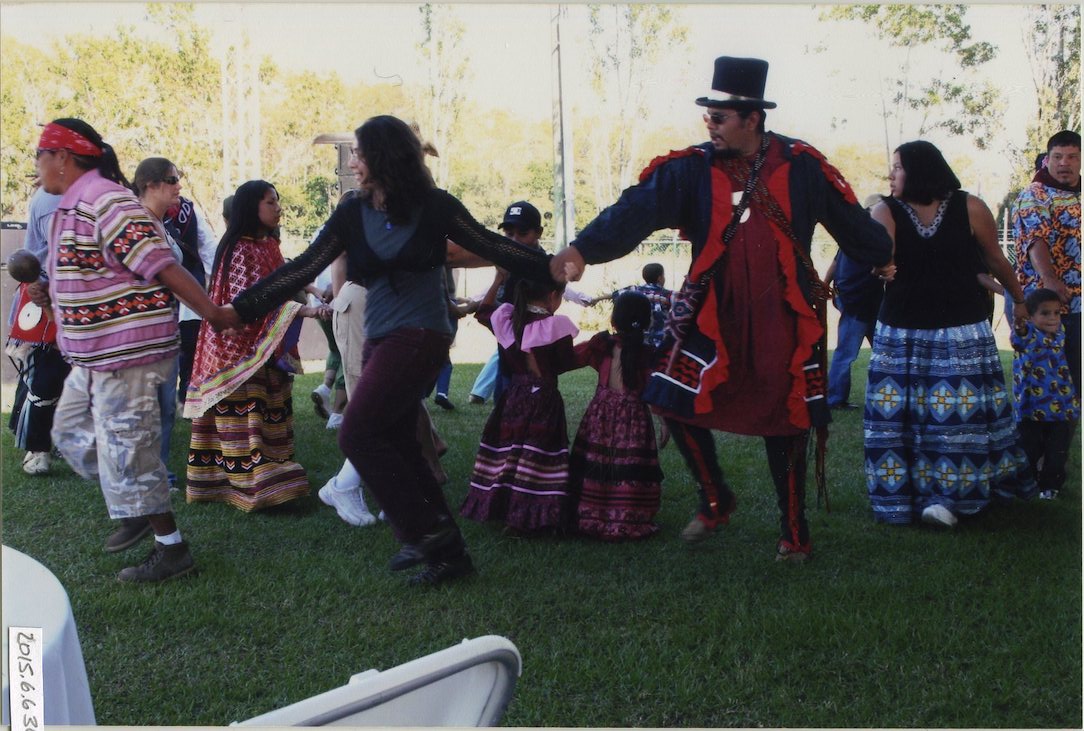
Sweet and Savory Seminole Treats!
Are you ready for a treat? No tricks! In a previous blog post, we explored some Seminole foods, and how their harvest and use was an act of resistance and resilience in the face of grave threats and a changing world. This week join us to get a closer look at traditional Seminole treats, recipes you can try at home, and how and where you can taste some of these special foods. Later, in the second part of this two-part exploration into Seminole foods, we look at some unique harvested foods that are important in traditional Seminole subsistence, such as Seminole pumpkins, coontie, and cabbage palm. We will also take a closer look at how Indigenous cooking is an act of reclamation and resistance after centuries of pressure.
Below, you can see Susie, Martha, and Bobby Billie around an open fire. The Gulf Stream Card & Distributing Company of Miami distributed the image as a postcard in 1954. In addition, to learn more about how postcards featuring Seminoles became popular, check out a previous blog post on the Power of Postcards!

State Archives of Florida
The Heart of the Camp
Like many of us, cooking and food is at the heart of the family. Similarly, in a traditional Seminole camp the cooking fire was a central camp location in a special chickee. The chickee “had open ends or open pockets to allow smoke from the central fire to escape. It was not uncommon to hang pots, pans, and drying meats from the roof rafters of the cook chickee. Everything was easily accessible and off the ground, away from water and wild animals” (Dilley 82). The cooking chickee, featuring the ever-burning “star fire” became a central meeting location, much like how we may gather around a kitchen table. Seminole women kept the central fire burning around the clock, and often sofkee and coffee were waiting over the fire.
The design and construction of the fire itself was similarly unique. The logs of the fire “pointed in the four cardinal directions – east, west, north, and south” (Dilley 83). In 1913, Alanson Skinner, an anthropologist with the American Museum of Natural History, described the central cooking fire. He observed “large cypress logs are cut and laid under the cook-house, radiating from a common center like spokes of a wheel. At the ‘hub’ the fire is lighted, and as the wood burns it is constantly shoved inward and hence never needs to be cut into shorter lengths. At this fire, the only one in the camp, the women cook for the entire village” (Skinner 70).
In our featured image this week, you can see an image taken in the early 20th century of a group of women cooking at Chestnut Billie’s Seminole Indian Village off Tamiami Trail. Note the spokes of the cypress logs, and how longer logs may have been pushed into the fire as needed.
Fry Bread
Fry bread is a staple across Indian country, although regionally each area has slightly different recipes. It is newer in the Seminole recipe book than sofkee or other traditional items. But, it is a beloved Seminole treat! Generally, Seminoles make fry bread from a mixture of oil, flour, and water. Seminoles would make this versatile bread in large batches to feed entire extended families or camps. It can be made sweet or savory, or even incorporated into a heartier meal. Indian fry bread tacos are a favorite! Looking to try an Indian taco or fry bread outside of a Pow Wow or event? Stop by Swamp Water Café on the Big Cypress Reservation. Below, you can see a Seminole woman flips fry bread in hot oil on the Brighton Seminole Indian Reservation in 1997.

Lusth, State Archives of Florida
Pumpkin Fry Bread
A sweet seasonal variation on traditional fry bread, the earthy pumpkin fry bread is a personal favorite. The recipe below is from Jenny Johns, and the Brighton Cultural Center. It was published in a 2012 Seminole Tribune article. In it, Johns noted how important food was to the Seminole tradition, stating that “We ate off the land, so we tried to grow everything we can grow.” Pumpkins, which are a traditional staple in the Seminole diet, were an easy addition to the basic fry bread recipe. But, before you try it, please note that fry bread is often made for large gatherings, and the below recipe feeds 50 or more.
Ingredients
- 1 6-lb., 1-oz. can of pumpkin (Libby’s) (or fresh pumpkin can be chopped and boiled)
- 5 lbs. of white sugar
- 5-7 lbs. of self-rising flour
- A large pot filled about halfway with vegetable oil (Mazola corn oil)
Directions
- Mix pumpkin, sugar, and flour together in a bowl. If you have time, cover mixture and let sit overnight. This will result in a less-sticky batter that will fry up fluffier.
- Lightly coat hands in flour and roll small handfuls into balls. Troubleshoot the dough. If it is too sticky, add more flour. If it is too dry, add more pumpkin. Not sweet enough? Add sugar.
- Flatten balls into pancake-like discs to shape.
- Carefully slip discs into medium-hot oil to fry.
- Once edges start to brown, flip over with tongs.
- Wait until bread reaches a medium-brown color, then remove from oil.
- Place on paper towel to remove excess oil.
- Enjoy hot! Can be eaten sprinkled with powdered sugar or plain.
Sofkee
Seminoles make sofkee, a warm comforting porridge-drink, from corn or rice. Historically, Seminoles also made sofkee with coontie flour. You can learn more about coontie later in our second part of this Seminole foods series! Often, Seminole women would keep a pot of sofkee boiling over the star fire in the cooking chickee, and offer it to guests and visitors. In Skinner’s observations, he noted that guests are served sofkee communally, where “alternately, each one dipping into the common kettle with the common spoon, usually a huge wooden ladle” (Skinner 67). In fact, sofkee spoons are their own unique art form! Skilled makers carve them from a single piece of wood. These easily identifiable, curved spoons are made specifically for ladling sofkee. There are a number of examples of sofkee spoons in the Ah-Tah-Thi-Ki Museum Collection.
Sofkee is still a popular drink and Seminole treat, as well as being an important cultural staple. Today, sofkee is made both sweet or savory. Often, the cook flavors it with fruit, spices, meat, or pumpkin. Below, Tommy Jumper cooks sofkee over a fire as part of a “Seminole Culture Folklife Area” demonstration at the 1982 Florida Folklife Festival in White Springs, FL.

State Archives of Florida
Rice Sofkee
Rice or corn sofkee can be eaten plain or flavored with other spices, fruits, meat, or vegetables. Even basic cooks can tailor this versatile recipe to the ingredients on hand. This recipe for rice sofkee is from the Seminole Tribe of Florida website.
Ingredients
- 2 quarts of water
- 1 teaspoon baking soda
- 2 cups of white rice
- 3 tablespoon cornstarch
Directions
- Bring 2 quarts of water to a boil and add 2 cups of rice and 3 tablespoons of cornstarch, stirring occasionally to prevent rice from sticking to the bottom.
- Boil for approximately 12 minutes
- Lower heat then add teaspoon of baking soda stir frequently until rice is tender.
- Set and cool until tolerable temperature.
The American Indigenous Arts Celebration (AIAC) this November 3-4th, 2023
Are you looking to try some authentic Seminole foods like sofkee and fry bread? You are in luck! Come to this year’s American Indigenous Arts Celebration! This year’s event will be on November 3-4th, 2023. Admission is $10 for adults and $7.50 for seniors and students. Tribal members, children four and under, and museum members are free. Parking is free. Enjoy FREE admission to the Museum with purchase of a ticket to the event as a special benefit.
Join the celebration to experience Seminole and Indigenous culture, art, dancing, fashion, and (of course) food! Event highlights will include adult and youth fashion shows, live alligator wrestling, Native American dance performances by Native Pride, and the exciting return of New Zealand’s HAKA Māori Cultural Experience. Additionally, attendees can peruse booths featuring native arts and crafts, demonstrations, and food vendors. So, make sure to get some authentic Seminole cuisine, including fresh fry bread! Check back in in a few weeks for a detailed blog post about all the event offerings.
The event will be held on the Ah-Tah-Thi-Ki Museum Campus, 34725 West Boundary Road, Big Cypress Seminole Indian Reservation. Buy advanced tickets here!
Additional Sources
The author accessed these sources digitally. Page reference numbers may not align with paper and hardback copies.
Dilley, Carrie. Thatched Roofs and Open Sides; The Architecture of Chickees and Their Changing Role in Seminole Society. 2018. University of Florida Press. Digital.
Skinner, Alanson. “Notes on the Florida Seminole.” American Anthropologist, vol. 15, no. 1, 1913, pp. 63–77.
Author Bio
Originally from Washington state, Deanna Butler received her BA in Archaeological Sciences from the University of Washington in 2014. Deanna moved to South Florida in 2016. Soon, she began working for the Seminole Tribe of Florida’s Tribal Historic Preservation Office. Deanna was the THPO’s Archaeological Collections Assistant from 2017-2021. While at the THPO, Deanna worked to preserve, support, and process the Tribe’s archaeological collection. She often wrote the popular Artifact of the Month series, and worked on many community and educational outreach programs. She lives in Fort Myers, FL with her husband, two sons, and dog.



